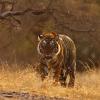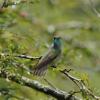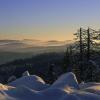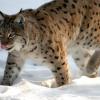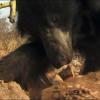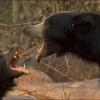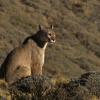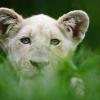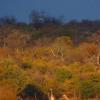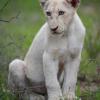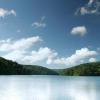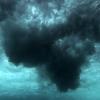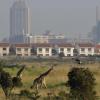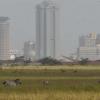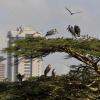A young tigress, called Baghani, is taken from her home in Ranthambore National Park and released in an unknown territory of Sariska National Park where all 24 tiger were killed by poachers. Baghani along with her mate Rajore have been chosen to start a new dynasty. For two years every aspect of their lives is followed by the camera. The film reveals an intimate and astounding insight into the private lives of these tigers and the animals they encounter in their new home. Will they survive and reclaim Sariska for the tiger?
Films 2012
First Prize – “Town of Sondrio” 2012
Stelvio National Park Award 2012 - Audience Jury Award 2012
This is the story of how hummingbirds became the greatest aerial acrobats on earth. Plants "created" hummingbirds as their messengers, carrying pollen from flower to flower. The film follows the evolution of the birds, as they are shaped by their role as "go-betweens". Hummingbirds have the highest metabolism of any vertebrate. They can hover, fly backwards and upside down. They have the smallest warm-blooded creature on earth in their number. These glittering birds live on the edge of what is possible, even going into a kind of hibernation each night, and all because of plants.
“Lombardy Region” Award 2012
When the bark beetle population exploded in the Bavarian Forest National Park in the 1980’s and the National Parks Administration refrained deliberately from practicing pest control, this decision had far-reaching effects. Within a few short years, several thousand acres of old, formerly commercially useful European spruce trees died off in the upper reaches of the forest. But then a miracle occurred. From the bark beetles’ path of destruction grew a new forest, more diverse and colorful than the former commercial forest had ever been before. Barely 30 years after the beetle-infestation, the idea of “Let Nature take its course”, propagated by the National Park Administration, can now at last prove its success.
Student Jury Award 2012
We all know him, we all love him: Baloo – Mowgli’s constant companion from The Jungle Book. Rudyard Kipling and even more the Walt Disney movie made this clumsy fellow world famous. The role models for Baloo are the Sloth Bears of India - surprisingly little is known about this secretive species. These in our days mostly nocturnal animals have never been portrayed in a natural history program before. Over a period of three years Oliver Goetzl and Ivo Nörenberg not only were lucky enough to film these elusive creatures at daytime but got also behavior that was even not known to scientists so far - e.g. the mouth feeding of cubs by their mothers.
Special mention
The puma is one of the most impressive but also one of the shyest animals of Patagonia. He is also an important component of an intact ecological system. This powerful wild cat not just only regulates the stocks of herbivores, they are also on the top of the food chain from which other animals profit a lot. Even though the puma is a protected species, they are hunted mercilessly. The Torres del Paine National Park is one of the few areas where the puma can find an intact naturally environment. Here they are able to hunt undisturbed and raise their cubs. In the rythm of seasons the film documented the life of a young puma with her three cubs. In one of the most beautiful landscapes of the world the camera accompanies the puma family – starting with the first meat meal of the two months old cubs – to their way of growing up and pass their first successful hunt.
Special mention
This is the story of two remarkable – and extremely rare – wild white lion cubs on their journey to adulthood. Both are female, sisters born as white as snow in May 2009 in South Africa’s Kruger Park. Growing up in this vast, wild wilderness they must not only overcome the same survival challenges that all lion cubs face, they must also overcome the threats their high visibility brings. In the African bush anything unusual stands out strongly and is often eliminated by eagle-eye predators. Will our cubs survive? The odds are stacked against them – 80% of the newborn lion cubs don’t make it to adulthood. We follow the cub’s progress as they embark the pathway to adulthood, learning to hunt, learning to avoid danger, learning to live in their white coats.
Hidden in the heart of densely populated central Europe is a little known wild secret. Here in a pristine swath of forested wetlands live the very last wild horses on the European continent. These few hundred survivors, known as the Dülmen horses, with their unique “eel” back stripes and zebra-like leg markings, live as they have for millennia. Beautiful and untamed, these animals are our last window into how horses live in the wild, their traits selected by nature rather than human breeding. This film reveals all aspects of the Dülmen herd’s existence, as well as the many fascinating species that share with them the rare and disappearing wooded wetlands of Central Europe.
Join a magical journey through the nature of Plitvice Lakes National Park. Float with the water and discover the dance of the elements, rock, woods, air and water. The beauty of things lies not only on the surface but in the infinite interplay of its individual parts. The film shows how the elements of nature merge into one. This is happening all around us. Like in the river Korana. Translated from Croatian the word Korana means water that runs through forest and rock.
In this intimate documentary, the film-maker makes a pilgrimage to the central United States where the annual spring migration of the sandhill cranes occurs along the Platte river. As she makes this journey the author compares the migration to her own transformation as she turns forty. The film interweaves facts about this most elegant of birds with existential questions that tend to resonate around the midpoint of our lives. The sandhill crane is a bird species known to mate for life; it is one of the oldest living birds and, as such, might have some things to teach us about our ability, or inability, to find a lifelong mate. The film features spectacular footage of these ancient birds and various landscapes of the route from Montana, the author’s home, to the Platte river in central Nebraska.
Šumava, or Silva Gabreta, as the Romans used to call it, is home to the largest fragments of natural and close-to-nature mountain forest within the Czech Republic. This film illustrates the role natural processes play in natural forest regeneration and proves that despite the dramatic disintegration stage we do not need to fear the future of Šumava spruce forests. Human expansionism has driven native European nature into tiny fragments in protected areas. We should, therefore, rightly show some humble respect for nature’s virtually boundless ability to restore and sustain itself.
The Kenyan capital of Nairobi combines opposites. This metropolis with three million inhabitants is among the most modern of cities on the African continent. At the same time, the Nairobi National Park begins practically at Nairobi’s doorstep. This is the boundary where raw wilderness and human civilization meet: just outside the city limits, a simple chain-link fence marks the edge of the Park where lions, hyenas, giraffes and rhinos roam through the grass. The film shows how humans and wild animals – side by side, and sometimes face to face – are sharing life in the big city.
From “Poland’s Amazonia”, between Biebrza and Narew up to the high mountains of the Tatra and into “Poland’s desert”, close to the Baltic Sea: wild Poland is full of natural wonders. No other country in Europe has more square kilometers of National Parks, many animals are still to be found here that have long since disappeared elsewhere in Europe: bisons and black storks, ruffs and elks. The film-makers spent twelve months making this documentary.
